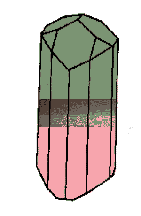Tourmaline, Carbon and Flint
By Editor Emeritus, Theo Steinhauer

Black Tourmaline
Black tourmaline, in long, prismatic, six sided crystals is one of the most interesting minerals found in many granites in the Sierra Nevada. In the slowly cooling granitic magma deep under the earth, the aluminum boro-silicate that forms the tourmaline crystallizes out of the melt when the magma reaches a certain temperature, forming radiating crystals.
While they do not have the gem quality of the beautiful pink and green tourmalines of pegmatite dikes, they are worthy of the interest of any collector.
Three Brothers of Carbon
One of the very common minerals in earth's crust is carbon. It is found in many compounds both in nature and in the laboratory. Carbon dioxide, a gas in the air, hydrocarbons in the oil of the earth, solid rocks such as limestone and other carbonates all are plentiful in the earth's crust.
Carbon also occurs, more or less in a pure state in nature, in three different forms. Amorphous carbon is found in Coal, and the charcoal and the charcoal of burned forests. Residues of all the earth's plants and animals contain carbon, as did the living residues that produced these residues.
Graphite is pure carbon and is found in many places in the earth's outer layer. It is hexagonal in shape and most often occurs in metamorphic rock formations. The single crystals are six sided thin plates and it is often used as an outstanding example of the relation of internal atomic arrangement influencing the gross physical properties of a material. It is soft and opaque, lower than average specific gravity 2.3, and is an excellent lubricant, fine for making pencil leads and crucibles and is extensively used in industry as a filler and in alloys.
Diamond, the third brother is rare and found in pipes or alluvial remains of these pipes. It is the epitome of hardness, heavy 3.5 specific gravity, and belongs to the cubic crystal system. It is a jewel and is used in industry as the cutting workhorse, par excellence, and is the working ingredient in all sorts of drills and abrasive tools.
Flint
Flint is a sedimentary rock occurring as fine grained nodules in chalk deposits, usually with a waxy luster and excellent conchoidal (clam shell-shaped) fracture. As flint, which is a form of silica SiO2, is hard and brittle and breaks into fragments with razor sharp edges, it was used by most prehistoric groups to manufacture instruments and tools.
 Flint outlasts copper and all other metals, and flint tools and weapons of early man give us record, though incomplete, of his life and habits. Many different kinds of native Americans from at least 9000 BC have left this kind of record.
Flint outlasts copper and all other metals, and flint tools and weapons of early man give us record, though incomplete, of his life and habits. Many different kinds of native Americans from at least 9000 BC have left this kind of record.
In the middle of the United States, a deposit of flint, called Flint Ridge, extends from Zanesville, Ohio to Newark. This area produced material for arrowheads, spearheads and knives used over a large area of the country. Some Indians traveled for hundreds of miles and traded other goods for this flint. Even today trails to and from this deposit can be followed for great distances.